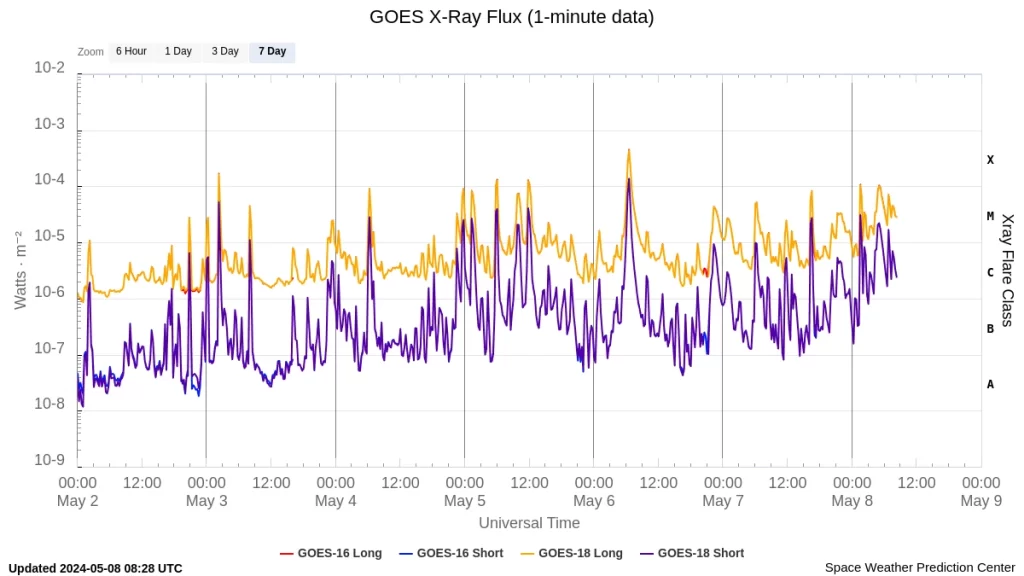Long-duration X1.0 solar flare erupts from geoeffective Region 3664, CME impact expected on May 11

A major solar flare measuring X1.0 erupted from Active Region 3664 at 05:09 UTC on May 8, 2024. The event started at 04:37 and ended at 05:32 UTC. Preliminary modeling efforts showed CME arrival time early on May 11. This is the second X-class solar flare of the day, following another X1.0 at 01:41 UTC.
A Type II Radio Emission with an estimated velocity of 1 152 km/s was registered at 05:01 UTC, suggesting a coronal mass ejection (CME) was produced.
A Type IV Radio Emission was registered at 05:08 UTC. These emissions occur in association with major eruptions on the Sun and are typically associated with strong CMEs and solar radiation storms.
Additionally, a 10cm Radio Burst (tenflare) lasting 22 minutes and with a peak flux of 570 sfu was associated with this event. This indicates that the electromagnetic burst associated with a solar flare at the 10cm wavelength was double or greater than the initial 10cm radio background. This can be indicative of significant radio noise in association with a solar flare. The noise is generally short-lived but can cause interference for sensitive receivers including radar, GPS, and satellite communications.





Radio frequencies were forecast to be most degraded over Asia, the Indian Ocean, parts of Australia, and West Pacific Ocean at the time of the flare.

Region 3664 is currently in a geoeffective position — favoring Earth-directed CMEs.
Additionally, it has a ‘beta-gamma-delta’ magnetic configuration and is capable of producing more strong to major eruptions on the Sun. Any CME produced by this region over the next few days has a good chance of being Earth-directed.


A halo CME associated with today’s X1.0 flare event is first visible in LASCO C2 imagery near 06:00 UTC. Preliminary modeling efforts showed an arrival time early on May 11. However, additional analysis and modeling are ongoing, SWPC forecasters said at 12:30 UTC today.


This was the second X-class solar flare of the UTC day, following an impulsive X1.0 at 01:39 UTC from Region 3663 — now located near the NW limb. CME was not produced by this event.
In 7 days to 08:00 UTC on May 8, our star produced 44 M-class and 6 X-class solar flares, most of them by regions 3663 and 3664.
The strongest CMEs produced by this activity were directed away from Earth.
It’s possible that a part of the CME produced on May 6 is heading our way. However, only a glancing blow is anticipated, causing unsettled to active geomagnetic field conditions on May 9.

| Max class | Time (UTC) |
|---|---|
| M4.5 | 05/8, 07:41 |
| M7.1 | 05/8, 06:53 |
| X1.0 | 05/8, 05:09 |
| M3.5 | 05/8, 04:30 |
| M1.9 | 05/8, 03:42 |
| M1.8 | 05/8, 03:27 |
| M3.4 | 05/8, 02:27 |
| X1.0 | 05/8, 01:41 |
| M8.2 | 05/7, 16:30 |
| M1.0 | 05/7, 13:35 |
| M1.0 | 05/7, 13:25 |
| M1.5 | 05/7, 12:54 |
| M2.4 | 05/7, 11:50 |
| M1.3 | 05/7, 08:23 |
| M5.1 | 05/7, 06:16 |
| M2.6 | 05/7, 00:58 |
| M4.3 | 05/6, 22:27 |
| M1.2 | 05/6, 21:48 |
| M1.5 | 05/6, 09:59 |
| X4.5 | 05/6, 06:35 |
| M1.3 | 05/6, 05:28 |
| M1.6 | 05/6, 01:06 |
| M1.3 | 05/5, 19:52 |
| M1.0 | 05/5, 18:40 |
| M1.3 | 05/5, 17:01 |
| M2.2 | 05/5, 15:38 |
| M1.3 | 05/5, 14:47 |
| X1.2 | 05/5, 11:54 |
| M7.4 | 05/5, 10:00 |
| M2.3 | 05/5, 09:38 |
| M1.3 | 05/5, 08:19 |
| X1.3 | 05/5, 06:01 |
| M8.4 | 05/5, 01:27 |
| M9.0 | 05/4, 23:48 |
| M3.2 | 05/4, 22:37 |
| M1.3 | 05/4, 18:20 |
| M1.5 | 05/4, 07:07 |
| M9.1 | 05/4, 06:19 |
| M1.6 | 05/4, 00:36 |
| M2.4 | 05/3, 23:30 |
| M1.0 | 05/3, 23:16 |
| M1.2 | 05/3, 22:47 |
| M4.4 | 05/3, 08:11 |
| X1.6 | 05/3, 02:22 |
| M2.7 | 05/3, 00:15 |
| M2.7 | 05/2, 20:57 |
| M1.0 | 05/2, 02:17 |
| M1.8 | 05/1, 22:31 |
| M1.9 | 05/1, 14:44 |
| M1.8 | 05/1, 14:32 |
Solar activity is expected to persist at moderate to high levels through at least May 10, with M-class flares (R1 – Minor to R2 – Moderate) expected (90%) and a high chance for X-class flares (R3 – Strong / 25%), due to the continued flare potential of Regions 3663 and 3664.
Featured image credit: X1.0 solar flare at 05:09 UTC on May 8, 2024. Credit: NASA SDO/AIA 304, Helioviewer, The Watchers

Commenting rules and guidelines
We value the thoughts and opinions of our readers and welcome healthy discussions on our website. In order to maintain a respectful and positive community, we ask that all commenters follow these rules.